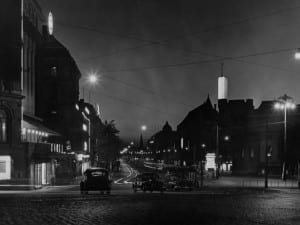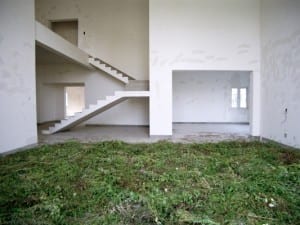Text by Bethany Rex
For its inaugural exhibition in London, Moving Image presents works by 28 artists represented by 28 galleries and non-profit institutions from South America, Asia, the Middle East, Europe and the United States. Presenting 19 single-channel videos and 9 larger-scale video sculptures/installations, Moving Image has been conceived to offer a viewing experience with the excitement and vitality of a fair, while allowing moving-image-based artworks to be understood and appreciated on their own terms. Taking place in the Bargehouse, a raw, four-storey warehouse space behind the OXO Wharf Tower, conveniently located within walking distance from both the Tate Modern and the Southbank Centre along the Thames, Moving Image represents a broad survey of artists invited by an international committee of curatorial advisors.
Aesthetica caught up with Ed Winkleman, co-founder for Moving Image, to discuss the increase in interest in video art and the possibilities of the medium.
Could you tell us a bit about how the fair started?
Moving Image began as an idea after Murat and I traveled to Los Angeles for the California Video (15 March – 8 June 2008) exhibition at the Getty Center. We were very impressed with the installation design, as it permitted a great deal of moving-image-based work to be presented in relatively small space, while still presenting the works on their own terms. We came away from that exhibition feeling that 1) video as shown in most art fairs is too often compromised, and 2) it wouldn’t require a terribly gigantic space to present a solid survey of video in a venue and still present it well.
The space the New York version took place in (the Waterfront Tunnel) is right next to our gallery, as well. We had been thinking for a while about producing a video exhibition in there. A member of our first curatorial advisory committee convinced us we would do better to turn it into a fair instead.
How do you translate moving image into the language of an art fair?
We are very careful to ensure the energy and vitality of a fair is preserved in how we install the Moving Image fair. It’s important that visitors should be able to see each other and talk to each other. It’s important too that they can sit and chat about what they saw…as well as sit and spend time with the videos they wish to. We took a page from the Getty’s installation playbook to arrive at a modular approach to showing the single-channel works in the fair, permitting visitors to gravitate toward the works that jumped out at them, but continue to pass by the ones that don’t. Once they choose one, the can sink into viewing it, taking a seat, putting on headphones, etc. but not losing sight of the actions around them. It worked very well in New York. We’ll see in London.
Referring to the title of the fair ‘An Art Fair of Contemporary Video Art’ – would you not say that all video art is contemporary?
Good point. I would agree. We did shorten it recently to just “Contemporary Video Art Fair” and I think it will remain that, even though, you’re right that there’s no such thing as non-contemporary video. I think the phrase is aesthetically more pleasing than just “Video Art Fair,” but I’ll ask the next Curatorial Advisory Committee…see what you’ve started!
What is the Curatorial Advisory Committee’s role and how do they come to a decision?
The Curatorial Advisory Committee recommend 10-15 artists each that they feel are doing strong work in video. Moving Image then contacts those artists’ galleries (or non-profit institutions working with them if they don’t have galleries) and invites them to participate. It takes several months of conversations to find just the right balance, but our committee members have all been amazing and very helpful.
Coming on to the display, the minimal exhibition design is a great way to include a large number of works in the space without it being overbearing. How will the work be displayed in the London show and what were your thoughts behind this set up?
The Bargehouse has 12 rooms that we will use for various types of installations. A few will be small cinemas. Others will be more like a biennial style installation. Our production team came up with an elegant monitor stand made from recycled wooden shipping palettes. This fits the raw industrial aesthetic of the Bargehouse perfectly, and is a nice way to be a bit green in the process. Most rooms will have 2-3 works maximum giving each enough space to be viewed without crowding or overlapping audios.
Video art is such a broad term. What was the selection process like? Was there a conscious decision to choose work that would be easy to ‘’sell’’?
Moving Image is about selling the work. That’s why, despite its curatorial bent (there are intentionally historical works that anchor the more recent pieces, and intentionally a wide international spectrum to serve as a snapshot or survey from around the world), we still call it an “art fair.” We know how expensive video is to produce, we know its market remains in its infancy, and we believe that the work needed to convince collectors that video is an extremely important part of the work contemporary artists are making is time well spent as that market stands to follow photography and become huge in the next decade. All the participating galleries are conscious of this, but they also understand that we’re working to present the videos on their own terms, so while they’re working for sales, they’re not having to compromise (too much) in presenting the work.
The Curatorial Advisory Committee selected the artists that appeal to them. The galleries most likely did consider sales in finalizing what to present, but, again, within a context that is designed to ask viewers to slow down and consider the work for what it is.
Could you talk us through your personal highlights in the show?
We are thrilled to have works from the 1970s by Dara Birnbaum and Hannah Wilke in the fair. These pioneers of video art are both receiving a fresh look by museums and galleries alike, and they help anchor the newer works in the show. We’re also very happy to have works from nearly every quarter of the world: Asia, South America, the Middle East, Europe, North America. The breadth of the exhibition is, to my mind, impressive and we’re very grateful to the Curatorial Advisory Committee for making it so.
How does the London fair differ from the New York edition?
One of the ideas for each fair is to respond to the architecture of the space. In New York we had one long hall. In London we have a four-story warehouse. We’ll have a few more installations in London than in New York, and as I noted above, a few mini-cinemas. We’re also presenting in collaborations with Film Co Lab, a Bring Your Own Beamer performance (in lieu of a panel discussion).
Moving Image is brand new (literally, only about 6 months old). We’re learning as we move forward!
Moving Image will take place October 13-16, 2011, during Frieze Art Fair in London and within short walking distance of the Tate Modern. Located in the Bargehouse in the Oxo Tower Wharf on the South Bank, Moving Image will be free to the public and open Thursday – Saturday, October 13 – 16, 11 am – 7 pm, and on Sunday, October 16, 11 am – 6 pm.
Aesthetica Magazine
We hope you enjoy reading the Aesthetica Blog, if you want to explore more of the best in contemporary arts and culture you should read us in print too. You can buy it today by calling +44(0)1904 479 168. Even better, subscribe to Aesthetica and save 20%. Go on, enjoy!
Image:
Chen Shaoxiong
Ink History 2010
Video 3:00 minutes
Courtesy of Pékin Fine Arts Bejing,
China





